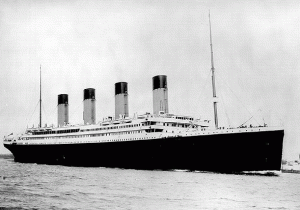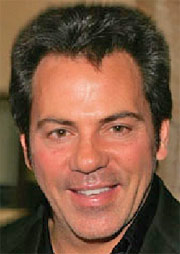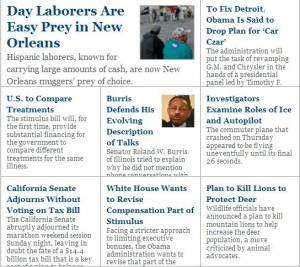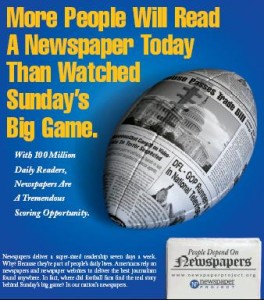The New York Times Co., which is struggling just to hold its business together, reported a loss in the first quarter as advertising revenues dropped a sickening 27%. The only good news is that the company delayed some debt payments and the CEO said there are signs that ad spending might increase in the third quarter.
The company’s performance dramatically undershot Wall Street estimates, where analysts were expecting a loss of 3 to 6 cents a share. The actual operating loss was 34 cents. Even online revenue, which was traditionally been a bright spot, was down 5.6%.
Media General also disappointed the few analysts who continue to follow the company, reporting an operating loss of 77 cents a share on an 18% drop in revenue. One analyst had pegged the likely loss at 5 cents a share on revenues of $180 million. Actual sales were a little under $160 million.
Moody’s has downgraded Gannett Co. yet again. The agency lowered its rating of the publisher into junk territory earlier this year and has since lowered it again. Now Moody’s says Gannett may not have the necessary profits to meet the terms of one of its debt convenants. Gannett logged a 60% drop in profit on an 18% slide in revenue in its most recent earnings report.
And there are more earnings still to come.
Specialty Publishers Hold Their Own
The 10,000-circulation weekly Jackson County (Mo.) Advocate focuses on serving its own neighborhood and it’s doing just fine, thank you. Sure, its four-person staff works long hours to produce the weekly, but employees will also stop to talk with residents who stop by the office because that’s where the best stories come from. Like the local man who found an image of the Virgin Mary on a rock in his back yard. “You never know who’s going to come through the front door,” says Editor Andrea Wood, who’s interviewed in this five-minute report by local radio station KCUR. “We’ve done stories about people who had grown freakishly large pears. It’s about the community.”
Wood says the turmoil that’s killing large metro newspapers isn’t hitting hyper-local titles nearly as hard. “This industry is stable,” she says. “People use the [community newspaper] for scrapbooks. You’re never going to get that from the Internet.” Local businesses are also more stable and loyal advertisers.
The Advocate competes with the Kansas City Star, which has been cutting back local news coverage. That appears to be helping the Advocate. Circulation is growing and now tops 10,000 subscribers. The Star no longer sends reporters to cover local government meetings, leaving the Advocate as the main source of information about their community.
Further to the west, where the industry downturn has been very bad to the local newspaper industry, a veteran publisher of Chinese-language papers has actually started a new one. Brian Ho launched News for Chinese, a free monthly, just one month after the financial crisis hit. He admits that his motivations were unconventional: He got a great deal on real estate and started the business to keep the offices occupied while the market recovers. Nevertheless, local advertising has picked up nicely and, while he still isn’t making a profit, Ho says that may be in the cards. “If my newspaper can earn a small profit to support my employees, I will consider that as a success.”
Awaiting New Owner, Union-Tribune Frets About Its Politics

Alf Landon
Voice of San Diego reports on a conundrum at the Union-Tribune: it doesn’t know whether it’s conservative or liberal any more. The U-T has leaned to the right going back to 1936, when it endorsed Alf Landon for president even as Franklin Roosevelt won 62% of the vote. New owner Platinum Equity has no clear political bias. Its chief partner gave $20,000 to the McCain campaign, but the partner who has the most experience running newspapers seems to prefer Democrats. Also, Platinum is based in Los Angeles, causing some locals to worry that the owners won’t care about local politics. That could tip the balance of elections, since observers figure the newspaper’s endorsements typically deliver a 3-5% edge to candidates, who tend to be conservative. It will tip the balance even more if the new owners decide to adopt a liberal bias.
J-School Enrollments Soar As Jobs Vanish
Alana Taylor is an NYU journalism major who’s doing everything right, yet “I have no idea what I am going to do when I graduate,” she writes on MediaShift. The college junior has 4,000 Twitter followers, lots of professional connections on LinkedIn and a well-established personal brand, but the jobs just don’t appear to be out there. She interviews industry experts (including us) and gets discouraging news: working for a daily is a non-starter because many papers are going under and even the survivors aren’t paying a living wage. Starting a business is impractical in this economy. About the only hope for employment is to hook on with an Internet company and hope for the best.
Nevertheless, J-school enrollments are at an all-time high, which prompts BusinessWeek’s Sarah Lacy to ask “What are these people thinking?” Lacy writes on TechCrunch that her lack of journalism training made her a more successful journalist. “I don’t know how to write an inverted pyramid story or even really what that is. I do know how to write for different platforms, be scrappy and break news. I’ve had zero important alum connections and never got an internship at a big daily. And, in hindsight, that’s probably the greatest stroke of luck I could have had.”
Being free of the hidebound expectations of an irrelevant journalism style has freed her to adapt her reporting style to the new standards of the Web, she writes. In contrast, her friends who went to J-school found that the experience delivered no career value. In fact, it embedded habits that are proving to be liabilities in the free-form style of the Web.
Miscellany
This year’s Pulitzer Prize for local reporting goes to Paul Giblin (no relation), who teamed with Ryan Gabrielson for a five-part series in the East Valley Tribune about a local Sheriff’s questionable obsession with immigration enforcement. Unfortunately, the honor will be bittersweet for the Tribune, which laid off Giblin when it cut back to four-days-a-week last October. Jeff Bercovici notes the irony, and catches up with the Tribune’s publisher, who issues a rather embarrassing comment about winning journalism’s top prize: “I don’t think [Giblin’s dismissal] diminishes at all, frankly, the excellent work they did on that project.”
Unions in San Francisco continue to strike a remarkably agreeable attitude toward Hearst’s demands that they help reduce expenses at the Chronicle by $50 million or face shutdown of the paper. The union representing delivery truck drivers agreed to let the paper cut between 90 and 100 driver positions by hiring subcontractors for home delivery. In return, the drivers keep the right to deliver papers within the city limits. Annual savings are expected to top $5 million.
The Riverside (Calif.) Press-Enterprise has reportedly laid off an unspecified number of employees. No word on body counts, but Gary Scott lists the names of 14 reporters and editors whom he believes got the ax.
The New York Times’ Tom Zeller takes issue with Marriott’s recent decision to cut out delivery of newspapers to its hotel rooms because of environmental concerns. Assuming that guests are turning more to their laptops and PDAs for the news, Zeller wonders if the decision doesn’t actually increase carbon emissions. He finds evidence that in countries that produce most of their power from fossil fuels, a 30-minute snuggle with the newspaper is actually less damaging to the environment than a PDA power-read. Of course, you have to take into account the cost of delivery, the impact of logging trees for paper, etc. It’s all very complex.
Columnists are supposed to be controversial, and you have to give media critic and Newser exec Michael Wolff credit for stirring up controversy with his forecast that 80% of newspapers will die within 18 months. You also have to give media veteran Martin Langeveld credit for injecting reality into that outrageous comment. Langeveld pulls out his calculator and notes that for Wolff to be correct, two newspapers would have to close ever day for the next year-and-a-half. Sometimes mathematics is a great tool.
And Finally…
 The 31 newly laid-off employees at the Raleigh News & Observer decided to poke some rather vicious fun at the newspaper’s owner. They mocked up a front page comparing McClatchy to the Titanic, which sank 97 years and one week ago. The parody portrays McClatchy CEO Gary Pruitt as a happy-go-lucky ship captain who sees the icebergs coming but figures his ship will simply strike them a glancing blow and use the ice fragments for cocktails. “She was welded together from the hulls of several old steamships, including a leaky tub called the RMS Knight Ridder,” they write. You can download a PDF of the mock front page here.
The 31 newly laid-off employees at the Raleigh News & Observer decided to poke some rather vicious fun at the newspaper’s owner. They mocked up a front page comparing McClatchy to the Titanic, which sank 97 years and one week ago. The parody portrays McClatchy CEO Gary Pruitt as a happy-go-lucky ship captain who sees the icebergs coming but figures his ship will simply strike them a glancing blow and use the ice fragments for cocktails. “She was welded together from the hulls of several old steamships, including a leaky tub called the RMS Knight Ridder,” they write. You can download a PDF of the mock front page here.
The president and publisher of the Louisville Courier-Journal delivered a rousing defense of the newspaper industry a couple of weeks ago in a speech that was just published yesterday. Arnold Garson used facts, statistics and a few points of information we hadn’t seen before to argue that the industry’s impending doom is greatly over-exaggerated, concluding that “The Courier-Journal will publish my obituary and yours, but not its own.” The Newspaper Association of America (NAA) should make him an industry spokesman.




 Today is Newspaper Death Watch’s second birthday (you can
Today is Newspaper Death Watch’s second birthday (you can  It depends on the location. Areas of Europe that are well wired for the Internet and have robust wireless infrastructures, like the Nordic region, will probably see the need for newspapers decline more quickly than those that charge high fees for Internet access or do not have affluent populations. Eastern Europe, in contrast, will probably be a fairly robust market for newspapers for some time. Some cultures are also more invested in the newspaper model, as is the case in the UK. In general, Europe will discard print newspapers more slowly than the US because traditions are more embedded and, in some cases, government subsidies will keep print publications afloat. France is an example of that.
It depends on the location. Areas of Europe that are well wired for the Internet and have robust wireless infrastructures, like the Nordic region, will probably see the need for newspapers decline more quickly than those that charge high fees for Internet access or do not have affluent populations. Eastern Europe, in contrast, will probably be a fairly robust market for newspapers for some time. Some cultures are also more invested in the newspaper model, as is the case in the UK. In general, Europe will discard print newspapers more slowly than the US because traditions are more embedded and, in some cases, government subsidies will keep print publications afloat. France is an example of that.



 Is Mortimer Zuckerman losing it? Or perhaps
Is Mortimer Zuckerman losing it? Or perhaps 



